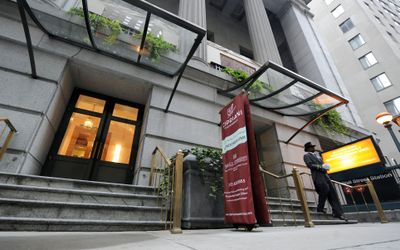Wall Street going residential
Storied financial buildings being converted into homes

NEW YORK – The former JP Morgan & Co. headquarters is one of Wall Street’s most famous landmarks, sitting across from the New York Stock Exchange since 1914. Today, the building is part of a luxury condominium complex that has a pool, screening room, bowling alley and apartments listed for nearly $11 million.
Down the street, more than 300 apartments are for rent at a 1907 Beaux-Arts tower that was once home to the Trust Company of America. Marjorie Levin and her family moved in a year and a half ago, looking for a neighborhood closer to water.
“There’s a lot of energy during the day, and it’s quiet at night,” Levin said. “And they’re all wonderful old buildings.”
Lower Manhattan has been cultivating a residential population for years in a district that once was all business, often by converting old office towers into rentals and condos after the Sept. 11 attacks. But residents and real estate experts are wondering what the future holds at a time when thousands of Wall Street jobs are being wiped out by the financial crisis.
At least a third of downtown’s new residents work in the financial services industry, and much of the rental and condominium traffic can be short-term corporate apartments.
“It’s really characterized as a transient market,” said Jonathan Miller, president and CEO of Miller Samuel Inc. in New York. “I certainly think it’s vulnerable.”
Lower Manhattan leaders say the residential market will help the financial district weather the economic crisis, supplying wealthier customers to support the area’s restaurants, hotels and upscale retail stores like Tiffany’s and Hermes.
The residential market “brings a critical mass for amenities that support the commercial,” said Elizabeth Berger, president of the Alliance for Downtown New York. “The big issue downtown is that Wall Street and Main Street are the same street.”
Developers first began a movement to convert office towers into apartments downtown in the mid-1990s after companies began migrating to midtown Manhattan, where employees had more options to move closer to work. After the 2001 World Trade Center attack, developers snatched up government incentives meant to provide a boost to a shattered economy and idle office buildings.
More than 10 million square feet of office space has been converted to homes downtown between 2001 and 2007, half in the last two years, according to the Cushman & Wakefield real estate brokerage. In that time, nearly 18,000 new residents have moved downtown, more than doubling the pre-Sept. 11 population, according to the Alliance for Downtown New York. More than 20 apartment buildings opened last year and another 35 are planned.
Lower Manhattan’s average household income has jumped nearly 60 percent in the past three years to about $240,000 a year, according to the alliance.
The converted high-rises sprouting along Wall Street reflect this increase in wealth.
The former “House of Morgan” across from the Stock Exchange is now known as “Downtown by Philippe Starck,” with apartments listed between $770,000 and $11 million, a fifth-floor roof deck overlooking the stock exchange, basketball and squash courts, a yoga studio and a bowling alley.
The former Brown Brothers Harriman bank headquarters, a neo-classical 36-story tower built in 1929, is now known as The Crest. The complex of more than 300 condominiums features a 10,000-square-foot “great room” with pool tables and a baby grand piano. The old Chase Manhattan headquarters on Pine Street sells luxury apartments redesigned by Armani/Casa.